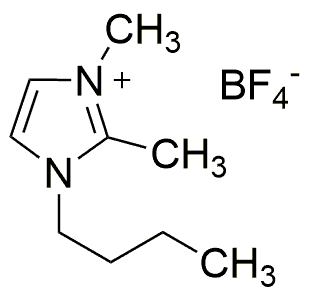1-Butyl-2,3-dimethylimidazolium tetrafluoroborate is widely utilized in research focused on:
- Electrochemical Applications: This compound serves as an electrolyte in batteries and supercapacitors, enhancing energy storage efficiency and stability.
- Green Solvent Development: It is used in the formulation of ionic liquids, which are environmentally friendly solvents in chemical reactions, reducing the need for volatile organic compounds.
- Biomass Processing: The compound aids in the extraction and conversion of biomass into biofuels, improving yields and reducing processing times.
- Electroplating: Its properties make it suitable for use in electroplating processes, providing better adhesion and surface quality compared to traditional methods.
- Sensor Technology: This chemical is applied in the development of sensors for detecting pollutants and other substances, offering high sensitivity and selectivity.
Informations générales
Propriétés
Sécurité et réglementation
Applications
1-Butyl-2,3-dimethylimidazolium tetrafluoroborate is widely utilized in research focused on:
- Electrochemical Applications: This compound serves as an electrolyte in batteries and supercapacitors, enhancing energy storage efficiency and stability.
- Green Solvent Development: It is used in the formulation of ionic liquids, which are environmentally friendly solvents in chemical reactions, reducing the need for volatile organic compounds.
- Biomass Processing: The compound aids in the extraction and conversion of biomass into biofuels, improving yields and reducing processing times.
- Electroplating: Its properties make it suitable for use in electroplating processes, providing better adhesion and surface quality compared to traditional methods.
- Sensor Technology: This chemical is applied in the development of sensors for detecting pollutants and other substances, offering high sensitivity and selectivity.
Documents
Fiches de données de sécurité (FDS)
La FDS fournit des informations de sécurité complètes sur la manipulation, le stockage et l’élimination du produit.
Spécifications du produit (PS)
Le PS fournit une description complète des propriétés du produit, notamment sa composition chimique, son état physique, sa pureté et les exigences de stockage. Il détaille également les plages de qualité acceptables et les applications prévues du produit.
Certificats d'analyse (COA)
Recherchez des certificats d'analyse (COA) en saisissant le numéro de lot du produit. Les numéros de lot et de lot se trouvent sur l'étiquette d'un produit, après les mots « Lot » ou « Lot de fabrication ».
Numéro de catalogue
Numéro de lot/série
Certificats d'origine (COO)
Ce certificat d'exploitation confirme le pays dans lequel le produit a été fabriqué, et détaille également les matériaux et composants utilisés et s'il est issu de sources naturelles, synthétiques ou autres sources spécifiques. Ce certificat peut être requis pour les douanes, le commerce et la conformité réglementaire.
Numéro de catalogue
Numéro de lot/série
Fiches de données de sécurité (FDS)
La FDS fournit des informations de sécurité complètes sur la manipulation, le stockage et l’élimination du produit.
DownloadSpécifications du produit (PS)
Le PS fournit une description complète des propriétés du produit, notamment sa composition chimique, son état physique, sa pureté et les exigences de stockage. Il détaille également les plages de qualité acceptables et les applications prévues du produit.
DownloadCertificats d'analyse (COA)
Recherchez des certificats d'analyse (COA) en saisissant le numéro de lot du produit. Les numéros de lot et de lot se trouvent sur l'étiquette d'un produit, après les mots « Lot » ou « Lot de fabrication ».
Numéro de catalogue
Numéro de lot/série
Certificats d'origine (COO)
Ce certificat d'exploitation confirme le pays dans lequel le produit a été fabriqué, et détaille également les matériaux et composants utilisés et s'il est issu de sources naturelles, synthétiques ou autres sources spécifiques. Ce certificat peut être requis pour les douanes, le commerce et la conformité réglementaire.


